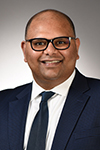 The International Team of Implantology Awards Dr. Shankar Rengasamy Venugopalan, Dr. Satheesh Elangovan, and Dr. Erliang Zeng Two-Year Grant Totaling $50,000 Dec 13, 2019 The International Team of Implantology (ITI) has awarded Dr. Shankar Rengasamy Venugopalan, Dr. Satheesh Elangovan, and Dr. Erliang Zeng $50,000 to study the epigenetic mechanisms leading to peri-implantitis. The principal investigator of this grant, Dr. Shankar Rengasamy Venugopalan, is an associate professor in the Department of Orthodontics. The co-investigators are Dr. Satheesh Elangovan, professor in the Department of Periodontics and Dr.Erliang Zeng, associate professor in the Division of Biostatistics and Computational Biology. Peri-implantitis, like periodontitis, is characterized by loss of alveolar bone beyond physiological limits, which makes it an irreversible condition and a complex problem to tackle. Currently, no single clinical strategy is available that can be utilized to treat peri-implantitis in a predictable manner. The epigenetic modifications play a significant role in the development of human diseases, such as cancer, neurological disorders, and autoimmune diseases. However, its role in peri-implantitis is not well characterized. Dr. Rengasamy Venugopalan and his team, with the grant funding from ITI, will study the epigenetic mechanisms underlying peri-implant pathologies using advanced next-generation sequencing technology. Understanding the epigenetic mechanisms behind peri-implantitis may help to develop novel and predictable preventive or therapeutic approaches. |
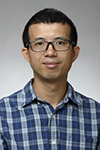 NIH Awards Dr. Huojun Cao a 2-year grant for over $300K Oct 04, 2019 The National Institutes of Health awarded Dr. Huojun Cao, assistant professor in the Iowa Institute for Oral Health Research and the Department of Endodontics, a 2-year grant for his project, “Computational Method for Identification of Master Transcription Factors in Craniofacial Tissues.” The long-term goal of Dr. Cao’s research is to identify master transcription factors that are responsible for craniofacial development. A master transcription factor is a gene that regulates other transcription factors and associated genes. Thus, a change in the master transcription factor can significantly alter the entire cell or tissue type, and it, therefore, shows great promise for regenerative medicine. Nevertheless, it is cumbersome, costly, and difficult to identify master transcription factors using experimental methods. Dr. Cao’s team has developed the prediction tool MTFinder to provide a computational method for identifying these master transcription factors. MTFinder incorporates both transciptome and epigenome data within a Bayesian statistical model so that the tool can identify master transcription factors in an inexpensive, efficient, and comprehensive manner. In preliminary studies, the tool successfully ranked all known master transcription factors in mouse embryonic stem cells and liver hepatocytes. Dr. Cao is now expanding this work to systemically identify master transcription factors that control craniofacial development. He has two aims in the project: 1. Evaluate and determine the optimal configuration of MTFinder in various cell/tissue-types. 2. Identify MTFs for craniofacial tissues using MTFinder with FaceBase’s transcriptome and epigenome data. The hope is that this line of work can properly identify master transcription factors for cell lineage reprogramming and thereby improve the prospect of regenerative medicine, disease modeling, and drug screenings among others. Dr. Cao’s team includes Dr. Brad Amendt, Dr. Xian Jin Xie, and Dr. Shankar Rengasamy Venugopalan. |
 NIDCR Awards Dr. Steve Levy Two-Year Grant Totaling Over $650K Sep 27, 2019 The National Institute of Dental and Craniofacial Research (NIDCR) has funded a new contract with Dr. Steven Levy (Wright-Bush-Shreves Endowed Professor of Research, Department of Preventive and Community, College of Dentistry, and Professor, Department of Epidemiology, College of Public Health) and colleagues at the University of Iowa. The Iowa Fluoride Study (IFS) and Iowa Bone Development Study (IBDS) have been funded by NIDCR research grants since 1991 and 1998, respectively, and have studied a cohort of participants from birth to age 24+. The new award is for the period of September 1, 2019 to August 31, 2021 for a total of $657,649. The focus will be on data management and sharing of the 28 years of data collected previously in the Iowa Fluoride Study and Iowa Bone Development Study. This includes detailed questionnaire data starting from birth on fluoride exposures, tooth brushing, dietary patterns, and other factors; physical activity questionnaires and assessments with motion sensors; dental examination results for dental fluorosis, dental caries, malocclusion and other dental conditions; bone densitometry assessments; genetics data; and other study information. All study information will have individual identifiers removed and then will be prepared for sharing with other researchers in the United States and around the world. Then these data will be placed into a special repository supported by the National Institutes of Health and interested researchers will apply to have access to the data. Other faculty directly involved with the new award are Drs. John Warren and Teresa Marshall (Professors, Department of Preventive and Community Dentistry), Dr. Kathy Janz (Professor Emeritus, Departments of Health and Human Physiology and Epidemiology), and Dr. Punam Saha (Professor, Departments of Electrical and Computer Engineering and Radiology). Also assisting will be Dr. Xian Jin Xie (Professor, Division of Biostatistics and Computational Biology/Iowa Institute for Oral Health Research/Department of Preventive and Community Dentistry) and Dr. Veeratrishul Allareddy (Professor, Department of Oral Pathology, Radiology, and Medicine). Other faculty involved in the previous collection and ongoing interpretation and reporting of all the IFS/IBDS data are: Dr. Justine Kolker (Department of Operative Dentistry), Drs. Karin Weber-Gasparoni and Michael Kanellis (Department or Pediatric Dentistry), Dr. Joseph Cavanaugh (Department of Biostatistics), Drs. James Torner, Trudy Burns, and Linda Snetselaar (Department of Epidemiology), and Dr. Julie Eichenberger-Gilmore (Iowa City Veteran Affairs Medical Center). |
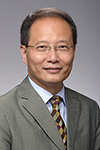 Dr. Xi Chen Receives Two-Year $426K Grant From NIH Sep 20, 2019 The National Institute of Nursing Research awarded Dr. Xi Chen, associate professor in preventive and community dentistry, a two-year R21 grant totaling over $426K for his project “Functionally-tailored Oral Care Intervention for Community-dwelling Older Adults with Dementia and Their Caregivers.” Dr. Chen’s research project focuses on the oral health of older adults who have dementia and yet live in the community, rather than in a nursing home. These persons tend to have poor oral hygiene and a high risk of dental decay and other oral diseases, and their oral health declines can significantly diminish their overall health and well-being. Dr. Chen said, “As a result of cognitive impairment, persons with dementia gradually lose their ability to perform oral self-care. They have to rely on caregivers for mouth care. However, the help from family caregivers is often limited because caregivers often don’t know how to assist their loved one, especially those with resistant behaviors. As a result, oral health is often poor in persons with dementia living in community, which can not only cause pain, infection and other systemic issues, but also make the relationship tense between caregivers and care recipients. We therefore want to develop a program to help these patients and their family caregivers.” Dr. Chen’s prior research has investigated how oral-health interventions can improve overall health of older adults with dementia. With the support of his NIH K23 Career Development Award, Dr. Chen developed “The Dental Activities Test”, which enables dental professionals to objectively evaluates the deterioration of oral self-care resulting from cognitive impairment. Together with his colleagues, Dr. Chen also developed the “Mouth Care Without A Battle”, which has become a standard oral hygiene protocol for residents of nursing homes in many states. Based on his previous work, Dr. Chen’s current project will create an individualized oral hygiene intervention for community-dwelling persons with dementia and their caregivers, in order to improve oral health in persons with dementia, reduce oral care burden in family caregivers, and improve care partner relationships. The project has two specific aims: 1. Develop a staged and modifiable dyadic oral care intervention to provide functionally-tailored oral care rehabilitation for community-dwelling persons with dementia and need-based skills training their family caregivers. 2. Evaluate the feasibility and efficacy of the intervention in home settings through a randomized, controlled trial with 40 pairs of persons with dementia and their primary caregivers, including immediate post-intervention and 3-month follow-up. Dr. Chen’s research team includes Dr. Xian Jin Xie from College of Dentistry, Dr. Sato Ashida from College of Public Health and Dr. Kristine Williams from the University of Kansas Medical Center. |
 The Sjögren’s Syndrome Foundation Awards Dr. Emily Lanzel $25K Grant Sep 06, 2019 Sjögren's syndrome is an immune system disorder that typically presents with two symptoms—dry eyes and a dry mouth. Although anyone can develop the disorder, most people aren’t diagnosed until later in life and the diagnostic process relies primarily on signs found in various tests (e.g., blood, eye, biopsy) that are used to rule out other medical explanations of the symptoms. The diagnosis is even more complicated for children, since when children have the syndrome, they often don’t present with dry eyes and a dry mouth. Dr. Emily Lanzel’s project ““Salivary biomarkers for diagnosis of childhood Sjögren syndrome” addresses this difficulty by identifying biomarkers of the disorder so that clinicians will have a much more reliable method for detecting Sjögren's syndrome in children. Although prior studies have observed biomarkers in the saliva of individuals with adult Sjögren's syndrome, Dr. Lanzel and her team will expand this work by finding the biomarkers present in the saliva of children with Sjögren’s syndrome. They expect that they will be able to develop a specific biomarker profile for children with Sjögren’s syndrome so that diagnosis can be done earlier and more precisely. An early diagnosis would give clinicians and researchers more time for testing early intervention strategies that could help identify effective therapies for the disorder. Dr. Lanzel’s research team includes Dr. Paula Gomez Hernandez (resident in Pediatric Dentistry), Dr. Scott Lieberman (College of Medicine), and Dr. Kim Brogden (director of the Iowa Institute for Oral Health Research) |
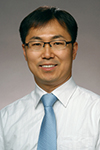 Dr. Kyungsup Shin Receives $20K Grant from the American Association of Orthodontists Foundation Aug 30, 2019 The American Association of Orthodontists Foundation (AAOF) awarded Dr. Kyungsup Shin (Orthodontics) a $20K grant for his project “Fracture Energy Assessment Using CBCT: a pilot study for predicting risk of Post-Traumatic Craniofacial deformities.” Dr. Shin’s Co-Investigators are Dr. Donald Anderson (College of Medicine), Dr. Veeratrishul Allareddy (OPRM), and Dr. Xian Jin Xie (Biostatistics and Computational Biology). Temporomandibular disorders are when injury or inflammation of the temporomandibular joint (the joint at the back of the jaw) causes pain in the area. About 60–70% of the general population are afflicted with the disorder, and it is particularly challenging to effectively treat without early diagnosis and treatment. Dr. Shin’s project is investigating whether cone beam computed tomography (CBCT) can be used to determine how likely it is for disorders to develop as a result of a traumatic event. Post-traumatic osteoarthritis is one of the most challenging degenerative joint disorders, and the degree of trauma plays an important role in the development of the disorder. Thus, Dr. Shin is using CBCT to determine the degree of trauma—that is, the objective fracture energy, and how that energy is distributed over different anatomical regions of the mandible. The method has been used previously in determining the fracture energy in long-bone (i.e., leg) fractures, and Dr. Shin believes it may be useful for trauma to the jaw as well. He has two primary aims in this pilot study: 1. Validate the objective fracture energy scores computed from CBCT data. 2. Determine the association between fracture energy and anatomical regions of the mandible. The ultimate aim is to develop a diagnostic tool for identifying the risk of developing a temporomandibular disorder, which can substantially improve early diagnosis and treatment. “This study was initiated with dental student summer research and I acknowledge the hard work of Ms. Isabella Jasek and Mr. Ryan Mooneyham. I also thank the Student Research Program, including Dr. Teresa Marshall, Dr. Justine Kolker and Dr. Satheesh Elangovan for their support. With my co-investigators, I will work for successful completion of this study so that this can be another preliminary work for further scientific investigation.” Dr. Shin and the Department of Orthodontics also received another subcontract grant from the University of Alabama at Birmingham to continue studying “Anterior Openbite Malocclusions in Adults: Recommendations, Treatment, and Stability.” |
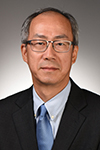 Dr. Liu Hong Awarded $45K Grant Aug 23, 2019 Synthetic bone-graft substitutes are considered a promising alternative approach to current standard treatments for oral and craniofacial bone defects. MicroRNAs (miRs) are small, non-coding RNAs that have emerged as important transcriptional regulators in both physiologic and pathophysiological conditions. The findings from preliminary research demonstrate that great potential exists to develop novel therapeutics for bone regeneration of craniofacial and periodontal bone defects by targeting miRs, and miR-200a specifically. The NaturemiRI, LLC R&D team has developed the Plasmid-based microRNA inhibitor system (PMIS), a non-toxic, nucleic acid-based method of microRNA inhibition. This particular research project is part of an overall series of projects intended to validate and commercialize a PMIS-infused collagen sponge for use in clinical dentistry. Specifically, Dr. Hong’s team expects to show that a PMIS construct inhibiting miR-200a (PMIS-miR-200a) promotes high-quality bone growth in the alveolar ridge of dental patients, thereby offering a new tool in the treatment of craniofacial defects and tooth extractions performed in anticipation of dental implantation. The project has three primary aims:
|
 NIH Awards Dr. Aline Petrin Grant Totaling Almost $700K Aug 16, 2019 Dr. Aline Petrin (Iowa Institute for Oral Health Research) has been awarded a 5-year career-development NIH K01 grant totaling almost $700,000 for her project, “A Twin Approach for Genome-Wide Differential DNA Methylation in Orofacial Clefting.” Dr. Petrin developed the proposal as a post-doctoral researcher with support from the college’s R90/T90 training grant. Dr. Petrin’s project draws on a powerful approach to the study of epigenetics and disease using discordant monozygotic twins to detect key epigenetics factors that play a causal role in orofacial clefts. The twin approach allows researchers to control for confounding factors, including genetic background, environmental exposure, age, gender, and other such effects, and thereby uncover epigenetic risk factors that are invisible to conventional genome-wide association studies and sequencing methods. Dr. Petrin and her mentors have successfully applied this twin approach to oral facial clefts (OFCs), and they have discovered the first causal gene for Van der Woude syndrome, the most common syndromic form of OFCs. Dr. Petrin’s project expands on this work. She hypothesizes that aberrant DNA methylation plays an important role in the etiology of OFCs and she, with the support of her mentors, gathered the largest (to date) set of monozygotic twins in which one has a nonsyndromic OFC and the other does not to characterize genome-wide differentially methylated regions that can impact the risk for orofacial clefts. Her two primary research aims are to:
Dr. Petrin expressed her gratitude for the grant and the support she has received from the college: “I am truly honored to receive this award and thankful for the support I have received from the Department of Orthodontics, the Iowa Institute for Oral Health Research, and the College of Dentistry. This award is a wonderful opportunity to leverage my knowledge of craniofacial genetics into the proposed epigenetic studies. I feel incredibly lucky for having a team of outstanding researchers and clinicians involved in the project and I will take this opportunity to further develop my line of research and skills as a mentor and educator.” |
 Dr. Shaoping Zhang Receives NIH Grant Jul 26, 2019 Dr. Shaoping Zhang (Periodontics) was awarded a three-year National Institutes of Health grant totaling almost $750,000. The project is part of Dr. Zhang’s ongoing work to better understand host-pathogen interactions at the mucosal surface, and this type of grant is intended to help independent investigators develop as a researcher. The hope is that this research will lead to the development of novel preventive, diagnostic, and therapeutic means to improve oral health and address periodontal disease. Dr. Zhang’s aims for the project are to: 1. Determine the role of the IL-17/TRAF3IP2 pathway-modulated local gingival immune response with a focus on IL-22 activity. 2. Investigate the role of the IL-17/TRAF3IP2 pathway in mucosal physical barrier function and mechanism of IL-17-regulated tight junction structure. 3. Determine the TRAF3IP2 variant effect on immune response as reflected by the transcriptional and post-transcriptional regulation of chemokine synthesis and barrier function in genomically engineered, human gingival epithelial cells. |
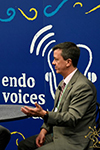 AAE to Launch Endo Voices Podcast Featuring Dr. Fabricio Teixeira Jun 07, 2019 Dr. Fabricio Teixeira (DEO Endodontics) was invited to participate in an educational podcast centered on advancing the art and science of endodontics while promoting the highest standards of patient care. It’s called American Association of Endodontist’s Endo Voices and intends to update endodontists on the hottest topics and trends in the field. The first episodes were recorded live on the exhibit floor at AAE19 in Montréal and will be published for listening in July. |
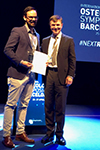 Dr. Miguel Romero-Bustillos Awarded Research Prize at the International Osteology Symposium May 17, 2019 The International Osteology Symposium was held in Barcelona April 25-27. This conference occurs once every three yeras, and it is one of the most prestigious scientific meetings in the field of oral regeneration. The 2019 meeting was attended by over 3,000 people from all over the world. A total of 318 abstracts were submitted to the conference, 221 of which were invited to give poster presentations and 6 were selected to give oral presentations. Dr. Romero-Bustillos, first year resident in the Advanced Education Program in Periodontics, was awarded first prize in Basic Research Competition for his presentation, "Understanding the development of dental supporting structures: Basis for the next regeneration." |
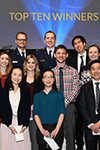 Dr. Hazard and Dr. Vislisel Receive Awards at the 2019 AAE Annual Meeting Apr 19, 2019 Dr. Mikaela Hazard and Dr. Jered Vislisel, both second-year Endodontic residents, each received awards for their oral presentations at the 2019 American Association of Endodontics Annual Meeting. According to Dr. Fabricio Teixeira, DEO of the Department of Endodontics, "this was a magnificent achievement considering the level of presentations at the meeting. We had a total of 875 presentations and the University of Iowa had two winners among the 10 ten in the Oral presentations category. They did a superb job and made all of us very proud."
|
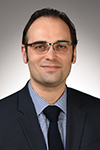
Mar 08, 2019 For each month spent on the International Space Station, an astronaut will lose approximately one to two percent of bone mass. Since the skeleton is not being used to support the full weight of the body, the bones weaken and lose mass and density. When a bone is not being properly stimulated, it usually undergoes disuse atrophy and subsequently shrinks. When a tooth is removed from its socket, this resorptive phenomenon also occurs with the alveolar bone—the bone that provides direct support to the teeth. Just as scientists have found ways for astronauts to maintain and strengthen bones while living in space, Dr. Gustavo Avila-Ortiz is exploring new therapies to preserve the alveolar bone. It is common to lose a significant amount of alveolar ridge volume in the first three to six months after a tooth extraction. “Without a tooth there to stimulate the bone, the alveolar ridge volume will decrease,” Avila-Ortiz explained. “Bone loss can lead to an intense remodeling of the contour of the alveolar ridge, which may make it difficult to replace a missing tooth with a dental implant,” he added. In the late 1990s and early 2000s, clinicians began to explore various ways to preserve the alveolar bone. “Over the years different bone substitutes, like bovine-derived xenograft or a human-derived allograft, typically applied in a particulate form, have been used to fill the tooth socket after tooth extraction in an attempt to reduce alveolar bone resorption. It has also been shown that sealing the socket orifice with a barrier material, such as a biocompatible membrane, is important to protect the underlying bone during the healing process. This approach, known as alveolar ridge preservation, is a widely used therapy in contemporary practice. But it is not the only available option” Avila-Ortiz commented. Another alveolar ridge preservation treatment involves intentionally leaving part of the tooth in the socket to stimulate the bone. “Although it can work, this treatment is technically hard, it isn’t always possible, and it may increase the risk of infections and failure of implant integration,” Avila-Ortiz said. Although he admits that there is no single fix-it-all solution, Avila-Ortiz has been researching how different biomaterials can preserve the natural architecture of the bone after an extraction, minimize the detrimental effects of tooth loss, shorten the healing time between extraction and placing an implant, and reduce the need for additional bone grafting to allow for implant placement. Recently, Avila-Ortiz has been working with Dr. Liu Hong and Dr. Brad Amendt, using the extraction socket as a research model, on therapies that would apply microRNA therapy for oral bone regeneration purposes. “It’s really very promising, and we are almost ready to initiate the first clinical trials with humans,” Avila-Ortiz said. One of the main goals of Avila-Ortiz’s research in this area is to discover both new therapies and the influence that patient-specific factors (i.e., local and systemic) have on the outcomes of treatment. “One size does not fit all. One of our objectives is to deliver individualized care to each of our patients,” Avila-Ortiz explained. |
|
The College of Dentistry’s Annual Local AADR Research Day Was a Great Success Feb 15, 2019 With over 100 presentations from students, staff, and faculty and an excellent keynote address by Dr. Rena D’Souza, the College of Dentistry’s Annual Local AADR Research Day was a great success. Our keynote speaker, Dr. D’Souza, is Professor of Neurobiology, Pathology, and Medicine and the Associate Vice President of Research at the University of Utah School of Medicine. As an outstanding scholar, leader, and mentor in our profession, she has held and continues to hold many prominent positions at her university and in the wider profession, including serving as President of the International Association for Dental Research, the 41st President of the American Association for Dental Research, and many other prominent positions related to oral health. According to Dr. Brad Amendt, this is the first time that the current IADR president has addressed the college for our Research Day. Dr. D’Souza expressed admiration for the college's efforts to develop an integrated research program that includes basic science, translational, and clinical research. She said that the college has become a cutting-edge institution in this respect, and in her opinion, it is why “Iowa is one of the top 10, if not top 5 dental colleges in the United States.” Dr. D’Souza’s keynote address covered a variety of topics including important areas for research in dentistry and the oral sciences, her goals for the IADR, and the specific kinds of genetic research that she has explored personally. College of Dentistry researchers are playing important roles in some of the important areas for research that Dr. D’Souza highlighted, including big data analysis, precision and personalized medicine, genomic research, microbiome research particularly regarding prebiotics or probiotics for the oral microbiome, and translational and clinical research. And Dr. D’Souza’s own research shows the great value of collaborating with colleagues in a variety of related fields—from clinicians working with basic science researchers to oral science researchers learning from hair follicle research. After her keynote address, Dr. D’Souza spent a great deal of time talking with faculty, staff, and students. It was a wonderful opportunity for the college to deepen our relationship with Dr. D’Souza. Pictures of Research Day Research Day really starts years in advance as students, faculty, and staff produce their research. These posters are a reflection of their work, and the support from our excellent staff in Ed Media. Presenters hung their posters the night before Research Day.
Research Day started bright and early with a great deal of snowfall the night before.
Dean Johnsen speaking with our keynote speaker, Dr. Rena D’Souza.
Despite the weather, Dr. D’Souza was speaking to big crowd.
A series of photos of students presenting their research
|
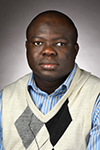 Dr. Azeez Butali Received a $25,000 Subaward Grant to Study Genetic and Environmental Risks for Oral Clefts in Puerto Rican Hispanics Feb 15, 2019 As a part of Dr. Butali’s broad collaboration with researchers around the world, Dr. Butali and his research team will sequence DNA from cleft families and controls from Puerto Rico. They will also analyze and interpret results. Furthermore, Dr. Butali will provide input on all aspects of future specific study designs, train personnel from the San Juan site, and assure safety and quality of the data. This project is part of his larger research goal of understanding population differences in cleft etiology and providing new insights in craniofacial development. Dr. Butali discusses this on-going work in this video. |
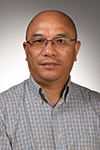 Dr. Erliang Zeng Awarded $68,652 Grant for a Project Investigating Tumors in Children Feb 08, 2019 The New York Institute of Technology (NYIT) granted Dr. Erliang Zeng a subaward grant for a project funded by the National Cancer Institute, a part of the NIH. The project, Molecular Circuit of Multi-ciliogenesis Regulates Choroid Plexus Differentiation and Tumor Development, investigates how the molecular circuit of malignant choroid plexus tumors in children interact with signaling pathways as the tumors are formed. Dr. Zeng will be responsible for leading efforts in bioinformatics development and data analysis for the project. Dr. Zeng brings significant expertise to provide outstanding support for the project on the omics data integration and bioinformatics analysis. This project will foster the already existing relationship and collaboration between subaward PI Erliang Zeng at UI and PI Haotian Zhao at NYIT and will strengthen the bioinformatics program development in the Division of Biostatistics and Computational Biology of the UI College of Dentistry. |
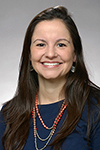 Dr. Erica Teixeria Continues Industry-University Collaboration with New Grant Feb 01, 2019 Tokuyama Dental Corporation awarded Dr. Erica Teixeria a $134,000 grant for the project, “Esthetic outcomes of a newly developed dental composite and adhesive system: a randomized clinical trial.” Dr. Teixeria’s project continues a long-term partnership between the College of Dentistry and Tokuyama. More specifically, Dr. Teixeria and her research team will conduct a 36-month randomized controlled clinical trial to evaluate and compare the esthetic outcomes and patient satisfaction of a simplified newly developed dental composite system for the esthetic region to a nanohybrid composite system. Although dental composite systems have been used extensively for the anterior region, it can still be difficult for clinicians to select the proper shade and the materials may not last as long as clinicians would like. This new system has been developed to improve the esthetic outcomes and patient satisfaction by enhancing its blending capability. Dr. Teixeria research team includes: Drs. Amira Ahmed, Steve Armstrong, Hanan Elgendy, Sandra Guzman-Armstrong, Aditi Jain, Justine Kolker, Rodrigo Maia, Patricia Meredith, Cristina Vidal, Marcos Vargas, Xian Jin Xie, and research coordinator Karen Kluesner. |
 A World-Class Program for Biostatistics and Computational Biology Jan 25, 2019
The Division of Biostatistics and Computational Biology provides statistical and computational expertise for the college’s research projects. Although in past generations statistical analysis was mostly performed by an individual researcher, it is now an expectation that elite biomedical research centers have a designated biostatistics division. “A single person is simply not adequate anymore. The databases are too large and of great complexity, and any person would have to know database management, frequentist methods, Bayesian methods, bioinformatics, structural equation modeling, etc.,” said Dr. Xian Jin Xie, director of the Division of Biostatistics and Computational Biology. Xie joined the college a little over a year ago in fall 2017, and since then, his division has worked with over 40 researchers at the college. Xie has really appreciated the collegial working environment. “Everyone is so easy to work with and the faculty really support one another,” said Xie. “This environment really lays the foundation for achieving more NIH grants, and potentially large multi-investigator program grants,” Xie added. Xie also underscored how much support he’s received from the college administration. “We have received great support from Dean Johnsen, Dean Schneider, and Dean Amendt. Everything we’ve asked for, they’ve given us.” And Xie has asked for a lot! Ultimately, he aims for the division to become a model for dental colleges across the country. “We are the first college in the country to have a division of biostatistics and computational biology,” Xie said. This new methodological focus is poised to become the new standard. Xie’s first year plan had three goals for accomplishing that ambitious goal. First, he sought to recruit high quality faculty and research staff, like associate professor Dr. Erliang Zeng, a new faculty member in the division who specializes in bioinformatics. Adding Zeng was crucial for establishing the division’s expertise in computational biology. Second, he wanted to continuing building on the college’s grant writing success, and his division has helped with 10 NIH grant submissions and many foundation sponsored grants this past year. Third, he plans to develop educational modules and one-hour lectures to help improve knowledge of statistical methods with the aim of helping all of our researchers, but especially our clinical researchers who want to do research but have limited time because of their extensive clinical responsibilities Although a great deal of Xie’s attention is dedicated to serving as the director of the division and advising on dental research projects, he also conducts and publishes his own statistical research on 1), statistical model diagnosis; 2), high throughput data analysis; and 3), new design of Phase I Clinical trials. “In my position, you need a breadth of knowledge to support various basic science and clinical research projects, but it’s always fulfilling and enjoyable to have your own research too,” said Xie. The Division of Biostatistics and Computational Biology is located on the first floor of the north wing of the Dental Science Building and is available for consults for upcoming research projects. |
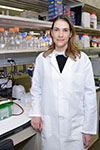 From the Bench to the Chair: Translational and Clinical Research at the College of Dentistry Jan 11, 2019 Dental researchers at the college have a strong history of pursuing basic, clinical, and translational research in a collaborative and supportive environment with the goal of improving patient care. “The ultimate goal of our research is to benefit and contribute to our community and society,” said Dr. Cristina Vidal, assistant professor in operative dentistry. The college’s translational and clinical research has flourished by drawing knowledge and experience from College of Dentistry colleagues and other disciplines—from medicine to physics, from public health to engineering. “Many questions in dentistry can be addressed, at least in part, with advances that have been made in other fields such as medicine or engineering. So I often start by asking ‘What approaches are being used in other fields?’” said Dr. Kyungsup Shin, assistant professor in orthodontics and director of clinical research for the college.
“Most of the 180,000 US dentists make radiographs in their offices, but they have minimal training in radiology in dentistry and often the scope of that training does not address quality assurance across all modalities of imaging in dentistry,” said Allareddy, “and that’s why it is so important to know how things should be done.” Having high-quality images requires a goldilocks level of radiation—just enough to get sufficient information for clinical judgments, but not too much, which exposes the patient to too much radiation. “Unfortunately, many of the digital intraoral radiographs that dentists take are not clinically useful as the patients are underexposed and the radiographs do not have enough information,” Allareddy explained. In addition to creating standards for the use of x-rays in dental clinics, Allareddy is also researching best practices for the use of cone-beam computed tomography (CBCT) in dentistry. CBCT technology is used when regular dental radiographs are not sufficient—for example, in cases of oral cancer or for dental implants. “Dentists need to be aware of what imaging tools are useful in which contexts; it’s really about optimizing our care for each patient,” Allareddy said.
Two of Vidal’s recent projects illustrate this line of research. In one, she is investigating a novel universal bonding agent that doesn’t require any light curing—and thus, it could reduce the time a patient spends in the dentist’s chair. Her research team will determine how well this new agent performs and make recommendations for its use in clinics. In another, her team is exploring how a certain plant-derived compound that can preserve, repair, and restore the bond between dentin and resin material. Although these particular clinical applications are important, Vidal is also interested in the underlying mechanisms. “By understanding both the enzymes that degrade collagen, and the natural processes that inhibit degradation of the resin-dentin bond, we will have a greater understanding of the most efficient and least invasive approaches in the clinic,” Vidal said.
After asking about approaches in related fields, Shin found out that an orthopedic research group (Dr. Don Anderson) had used medical CT images of leg fractures to determine the risk for developing arthritis as a result of the fracture. Shin wanted to apply that research to his specialty, the TMJ. Drawing on Allareddy’s expertise in radiology and CBCT images, Shin hopes to develop a predictive diagnostic tool using CBCT images to assess the risk of developing osteoarthisis in the TMJs after trauma to the joint. Post-traumatic osteoarthritis in this joint is particularly challenging to treat, often requiring extensive surgical procedures. “Without reliable predictive diagnostic tools, we don’t really know when to intervene to prevent long-term complications associated with post- traumatic osteoarthritis,” Shin explained. Shin has also been collaborating with colleagues in other colleges—Dr. Aliasger Salem in pharmacy and Dr. James Martin in medicine—on basic science research concerning bone and cartilage tissue regeneration in the TMJ. Allareddy, Vidal, and Shin are wonderful pictures of the collaborative, translational, and clinical research being conducted at the College of Dentistry. Whether patients are having a dental radiograph made, having a broken tooth repaired, or having surgery on their temporomandibular joint, these researchers are finding a way to make a difference. |